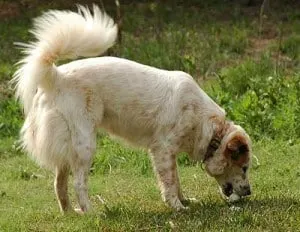If you live with dogs for a long time, as we both have, you might begin to think that you’ve seen everything. Then, out of the blue, you’re coping with something brand new to you.
We were in the middle of a quiet evening at home, working on some new product reviews and photos for a DogTipper update. Our pooches were in their usual evening poses, Irie ensconced on the living room couch and Tiki catching some zzz’s on our bed. Suddenly, cries of pain from the bedroom brought us running. Tiki was frozen in place, apparently unable to move from the bed, still uttering those alarming shrieks of pain. We petted and stroked her to calm her down, then began searching her for signs of injury.
One of our first thoughts was that she had been bitten or stung by an insect or wasp. In the past, we’ve seen (and been stung by) scorpions around the house, and late spring is when they usually seem to appear. They have a very painful sting, much worse than other insects. However, we found no obvious sting marks on her and the only area that seemed to be painful to our touch was at the base of Tiki’s tail. We soothed her as best we could and, after a few minutes, the pain seemed to go away–although the area at the base of her tail remained sensitive.

The morning after the onset of “cold tail”
Tiki resumed her usual activities, walking and eating, but one thing was different: she seemed unable or reluctant to raise her tail into its normal position. Tiki’s tail is large and plume-like and is usually curled up over her back, much like one of the Nordic breeds. When greeting us or Irie, she wags it energetically in a circling motion. Tonight, though, her tail was down, way down, nearly dragging the floor.

Tiki’s normal tail position
We encouraged her to lie on the couch beside her buddy Irie then debated what to do. Should we run her to the emergency vet? (And why do these things always occur at night?) We called some canine professionals and fellow dog lovers. The consensus: this was probably “cold tail,” a condition that usually affects hunting dogs or working breeds after strenuous exercise in cold or wet conditions. Watch her for a few days, make sure she gets lots of rest, and try a warm heating pad on the base of the tail if she’ll allow it.
“Cold tail” is similar to a strained muscle at the base of the tail and, in most cases, it heals up in two to four weeks. Although Tiki certainly wasn’t involved in retrieving ducks from an icy pond or tracking quarry through fields of snow, she apparently strained that muscle all the same. Earlier in the day, she’d been swimming in our creek which isn’t cold (it’s 95 degrees here right now) but it is spring-fed water so that makes it chillier than a swim in a river or lake. Perhaps that’s what caused the problem. Treatment usually calls for rest to allow the muscle to regain its strength.
Over the next few days, we watched her carefully for signs of distress. Her appetite and activity level was completely normal, and she seemed to be in no discomfort. She seemed totally recovered, except for her droopy tail.
Truly, “you don’t know what you’ve got ’til its gone.” During her bout with cold tail, Tiki’s very appearance was altered–and that made her personality seemed changed, too, although it really wasn’t. Her droopy tail conveyed a sense of fear or uncertainty. We missed her energetic wagging, and even Irie seemed to notice Tiki’s new body language.
Within two or three days, Tiki’s tail began to lift, slowly moving into a “J” position similar to the way a border collie holds his tail. Over the past two weeks, we’ve seen Tiki regain full use of her tail. After running errands the other day, she happily met us on our return, her white plume arched proudly over her back!
- Review: Jimmy BX7 Pro Anti-Mite Vacuum Cleaner - December 16, 2024
- 🎉 GIVEAWAY: Lord of the Pets Portrait of Your Dog! - November 26, 2024
- Review: Lord of the Pets Portraits - November 17, 2024
